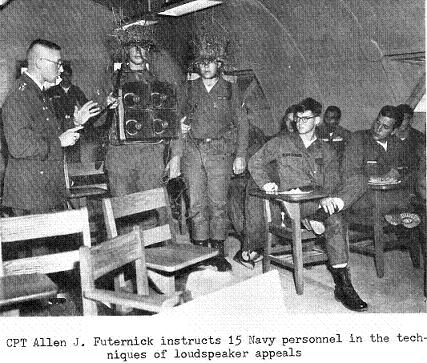The Mission of The 7th PsyOp Group and Role of The 14th PsyOp Battalion in 1967
In 1965, the 14th PsyWar Battalion was reorganized into the 7th PsyOp Group and 14th PsyOp Battalion. Until recently (3/06) the role of the 14th within the 7th was largely unclear. E-mail discussion with personnel in the 7th points to the 14th as being a "Paper Bn". Mike Johnson S-3 SSG from 1969-71 said the following:
We all were handled administratively by the 18th PSYOP Co. The 14th was just basically a paper unit with names assigned. The 14th, 16th and 18th were TO&E (Table of Organization and Equipment) units while the 7th, 15th, and B&VA PAC were TDA (Table of Distribution and Equipment) units. The 7th used personnel the way it needed them. For example, my driver clerk was assigned to the 16th but worked for the 7th Gp S-3 training. TO&E units have a set standard amount of people and equipment. Whereas a TDA unit is formed for a specific function and is unique unto itself. So the 14th almost always had no people working for it. It was a unit only on paper and used the people where they were needed.
Col Charlie Nahlik (Ret) who was in the 15th detachment from 1966-68 stated:
The 14th PSYOP Battalion was basically like the 7th PSYOP Hq.... It was a HQ with a LTC and mini-staff with the two companies an detachments under them. In my two years there, there was basically no interaction with or requirements from the Bn Hq
The role of the 14th Bn is now more clearly understood as a result of obtaining a 1967 unit history (provided by Major Carl Yasuda Ret). The role of 14th Bn was that of a tactical, deployable force as part of the 7th Group's Strategic mission.
Mission of The 7th Group:
To provide psychological operations support for the Commander -in-Chief, Pacific (CINCPAC): the Commander-in-Chief, Uniited Nations Command (CINCUNC); subordinate components and unified commander of CINCPAC; the the High Commissioner, Ryukyu Islands. Further, it conducts operations to exploit the psychological impact of military operations. At present (1967), the majority of 7th Psychological Operations Group resources are concentrated in strategic support of COMUSMACV.
Role of the 14th Battalion:
The 14th Psychological Operations Battalion is commanded by Lieutenant Colonel John A. Grubbs and is a tactical, deployable force. It is capable of moving to any area within the Pacific Command where psychological operation support is needed. Many of the Battalion's specialists, however, are working in the 15th PsyOps Detachment as a result of the added strategic missions assigned to the Group without compensating personnel increases.
As presently organized (1967), the Battalion is staffed according to MTOE 33500F and consists of a battalion headquarters, the 16th Psychological Operations Company (Advisory and Support) (Airborne). The rapidly expanding requirement for PSYOP forces has underlined a need for changes in the organization.
As evidence of that tactical role, the 14th Battalion records the following deployments and activities for the year 1967:
Four mobile loudspeaker teams from the 16th Company were deployed TDY for six-month periods in Vietnam. At year's end, two of these were still on the battlefield..Another team from the 16th went to the John F. Kennedy Center for Special Warfare at Fort Bragg, North Carolina, for specialized training on new radio equipment. This team after further training "back home on Okinawa" deployed to Vietnam on 7 December 1967 to install, maintain, and operate the new equipment. They, too, watched 1967 come to a close from their post in Vietnam.
The 18th PsyOps Company sent an audio-visual team to the Republic of Korea to assist various departments of the ROK Government in keeping villagers in remote areas informed of the dangers of communism and to inform them of ROK Government actions in their behalf.
Aside from the Specialized teams deployed, many men of the battalion received temporary duty assignments to countries throughout the Pacific Command. Vietnam, Thailand, Korea, Taiwan, and the Phillipines were home to members o the battalion for periods of up to six months.
AWARDS: While on TDY, battalion members rendered service in a variety of roles, including advisory, training, and operational missions. they also supported in-country units awaiting the arrival of permanent personnel from CONUS. The Bronze Star with "V" device, the Joint Services Commentation Medal, the Army Commendation Medal, and the Air Medal were received by some battalion members in recognition of their services.
SFC Heyward Rourk particularly distinguished himself during his service on a PSYOP loudspeaker team. SFC Rourk supported both Army and Marine elements in Vietnam and received wide publicity when he singlehandedly captured 15 Viet Cong who were hiding in a cave.
TRAINING: Various units received training by the battalion. Elements of the Special Action Force Asia received training on psychological operations oreinted towards Vietnam, Thailand, and other southeast Asia areas. Marine units received a psychological operations orientation before deployment to Vietnam, and a Navy Beach Jumper unit was given instruction on general psychological operations and loudspeaker operations to assist in their preparation for Vietnam

Men of the 18th PsyOps Company, as the airborne elements of the battalion, made more than 225 parachute jumps during the year on drop zones in Okinawa, Vietnam, Taiwan, and Thailand. Ten men completed basic air borne tranining conducted on Okinawa, and two completed Jumpmaster School.
In October, a Light Mobile Printing Plant was received from CONUS by the 18th PsyOPs Company and replaced similar equipment which had been given to Vietnam units earlier.